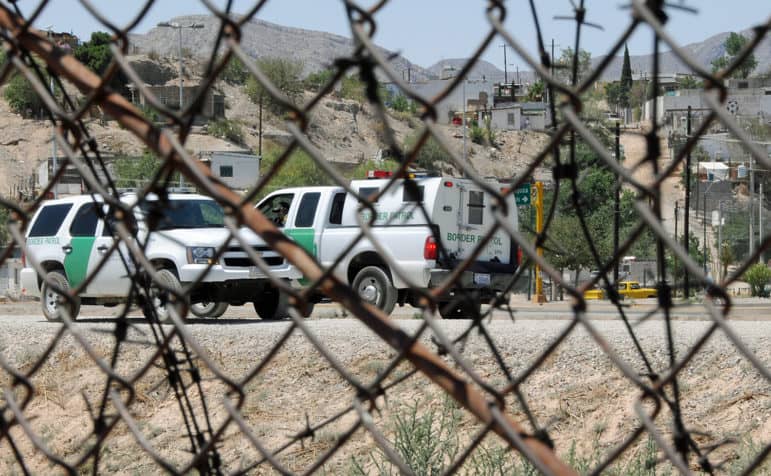
Heath Haussamen / NMPolitics.net
A scene from the U.S./Mexico border. In the foreground, behind a barbed-wire fence, U.S. Border Patrol agents speak with each other in El Paso, Texas. Across the Rio Grande, in the background, is Cuidad Juárez, Mexico.
It’s been a challenge for me to keep up with the flood of news about immigration and the situation at the border for the last couple of weeks. If it’s been difficult for you as well, I hope this post helps.
The children
The issue of immigrant children being separated from their parents has gained the most attention. Now that President Donald Trump has issued an executive order that appears to stop this practice, there’s still lots to track.
Trump says he wants to prosecute all illegal border crossings without separating families. That will be a real challenge, The Texas Tribune reports, because of capacity issues and a legal agreement — which former President Barack Obama also ran into — that generally requires that immigrant children be held in detention for no more than 20 days, even if they’re with their parents.
There’s also the issue of reunifying the 2,300 children or more who were separated from their parents before Trump put a stop to the practice. The federal government doesn’t have much of a plan for doing that. ProPublica reports on one girl who memorized a family phone number that is helping her not get lost in the system. The article shines light on how much responsibility kids will need to have in reunification.
Asylum seekers
People seeking asylum in the United States are also having problems. For starters, Attorney General Jeff Sessions recently reversed longstanding U.S. policy and said most people who are solely victims of domestic or gang violence aren’t eligible for asylum. And a woman seeking asylum at the Santa Teresa Port of Entry in New Mexico — apparently the right way to do it — was separated from her disabled grandson 10 months ago, which raises all sorts of questions.
In El Paso, families are sitting on bridges at border crossings waiting to be let in to plea their cases. American activists are standing with them and trying to speed the process.
Militarization
Meanwhile, the militarization of the border — and beyond — is getting attention. The Pentagon is making room for up to 20,000 migrant children on military bases, the Washington Post reports. The Pentagon has also agreed to send six active-duty JAGs — military lawyers — to the border to help prosecute cases, MSNBC reports. One is headed to Las Cruces.
And the U.S. Border Patrol is making waves in Maine for setting up a temporary checkpoint on an interstate and questioning motorists about their citizenship. They arrested one person.
That’s been legal for decades in the so-called border zone — the 100 miles of land on the southern, northern, eastern and western edges of the United States, where about two-thirds of all Americans live. We’re very familiar with it in Southern New Mexico, where permanent inland checkpoints mean we can’t leave the Las Cruces/El Paso area in any direction without answering questions from federal agents about our citizenship. I’ve written before about an awful experience my girlfriend and I had at such a checkpoint and about the experiences of others.
New Mexico politicians speak
Gov. Susana Martinez has given her support to the practice of separating immigrant children from their parents, while New Mexico’s entire congressional delegation — including Republican U.S. Rep. Steve Pearce — opposed it. New Mexico Political Report got the entire delegation on the record.
That news organization also has a good roundup of what New Mexico politicians have been doing and saying this week in response to what’s happening.
Seeing Tornillo
Many officials from around the nation have felt the need to travel this week to Tornillo, Texas, where immigrant children are being housed in a tent city at the port of entry, to see it for themselves. Some New Mexicans joined a protest there last weekend. The mayors of Albuquerque and Santa Fe were there Thursday. U.S. Sens. Tom Udall and Martin Heinrich of New Mexico and Richard Blumenthal of Connecticut were there Friday.
I visited Tornillo on Sunday. You can see my photos by clicking here.
The big picture
Meanwhile, land seizures in south Texas to expand the border fence appear to be on track. Children are being put in shelters with a history of abuse and neglect. And kids were forcibly injected with drugs, a new lawsuit claims. With all the hard-line policy changes Trump has implemented, people living in New Mexico without legal status are in fear. And this week’s immigration reform attempts appear, once again, to be dead.
Washington is paralyzed? Big surprise.
Last week, I expressed anger about Trump’s separation of children from their parents in a commentary. On Friday, I published a new column with my thoughts on the deeper issues revealed by Trump’s cruelty. I discussed the oppressive systems that enable his actions and argued that we all bear responsibility — and we all need to change. Read it by clicking here.
We need your help
Finally, a plea: We’ve been working overtime at NMPolitics.net to keep you updated on what’s happening at the border and beyond. Our ability to keep bringing you the news is dependent on your support. Please, make a donation or sign up to make automatic monthly contributions by clicking here.
And tell your friends to join our email list to keep up with the latest. They can sign up by clicking here.
Thanks so much for your support!
